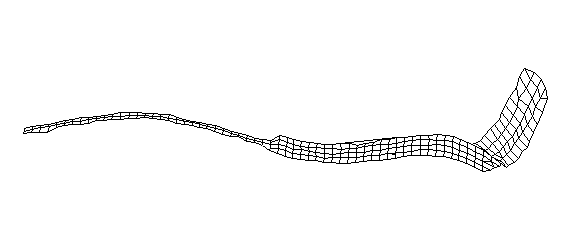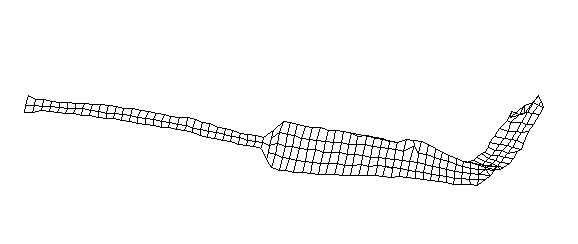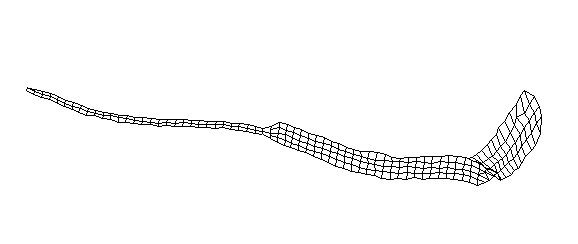

Fig. 1.Two modes of vibration of a composite goalie stick. (left) Bending mode at 261 Hz. (right) Torsional mode at 213 Hz.
Linda J. Hunt - ketteringhunt8831@gmail.com
Department of Physics
Kettering University
Flint, MI, 48504, USA
Daniel A. Russell - drussell@engr.psu.edu
Graduate Program in Acoustics
Pennsylvania State University
University Park, PA 16802, USA
Popular version of paper 3aED5
Presented Wednesday morning, November 2, 2011
162nd Meeting of the Acoustical Society of America, San Diego, CA
In the game of ice hockey, most players no longer use wood hockey sticks. Instead, the vast majority of players prefer sticks made from carbon fiber composites. However, goalies have not followed this trend; the majority of goalies still use wood sticks, even though composite goalie sticks are available from a variety of manufacturers. Anecdotal information suggests that goalies prefer wood sticks because they sting less when impacted by a puck traveling at high speed. The purpose of this paper is to determine whether acoustic and vibration signatures of goalie sticks can help explain this preference.
We used Experimental Modal Analysis to obtain mode shapes and frequencies for several wood and composite goalie sticks. A small accelerometer was attached to the top of the toe on the blade and a force hammer was used to tap the entire stick at 1-inch intervals over the entire stick surface. A frequency response function of the ratio of acceleration output to force input was obtained for each impact point. We used computer software to fit the data and to produce animations of the natural modes of vibration and their corresponding frequencies.
Figure 1 below shows two mode shapes for one of the composite goalie sticks. These mode shapes were chosen because their frequencies fall close to range of 200-400 Hz where the hands are more sensitive to vibrational stimuli, and they both involve significant vibration amplitude at the joint where the shaft meets blade, where the goalie grips the stick. The mode shape on the left is a flexural bending mode and the shape on the right is a torsional or twisting mode. These measured shapes do not include the hand holding the stick. When a stick is impacted by a puck hitting the blade, all of the structural vibration modes of the stick are excited at the same time.


Fig. 1.Two modes of vibration of a composite goalie stick. (left) Bending mode at 261 Hz. (right) Torsional mode at 213 Hz.
When we compared mode shapes and frequencies for several high-end wood and composite sticks, we found that the frequencies for composite sticks tend to be higher than wood sticks. This is not surprising because composite sticks tend to be lighter and stiffer than wood. The higher frequencies for composite sticks might help explain player preference for wood sticks. The first three or four bending and torsional modes of vibration have larger vibration amplitudes. The mode shapes that exhibit large vibration amplitudes near the grip point (at the junction of handle and paddle) contribute to the sensation of sting in the hands of the goalie holding the stick. If the frequencies of these important modes of vibration for a composite stick they fall into the frequency range where the human hand is most sensitive to vibration, then the excitation of these vibrational modes may be more readily perceived by the player.
Each vibrational mode shape has a certain amount of intrinsic structural damping associated with it; the damping rate determines how quickly the vibration dies away. Research on baseball bats has shown that bats with larger damping are perceived as producing less sting. When we measured and compared the damping rates for the modes of vibration of wood and composite goalie sticks we found that wood sticks tend to have damping rates between two and four times larger than composite sticks.
This analysis of the vibrational modes of goalie sticks helps to explain why players might prefer wood sticks over composite. For the bending and torsional modes of vibration that exhibit antinodes at the joint between shaft and paddle where the stick is typically held, and which have frequencies close to the range where the human hand is most sensitive, wood sticks tend to have lower frequencies and greater damping, while composite sticks have higher frequencies and less damping. Players apparently prefer sticks for which the frequencies are lower, and thus further from the range of maximum sensitivity, and for which the damping rates are larger, so that the vibration dies away faster.
Goalie sticks are often modified by the player in that they have a large amount of tape wrapped around the butt end of the shaft. NHL regulations require this layer of tape to be at least 1/2" thick, but many players use a much greater amount. This layer of tape provides two function. It softens the end of the stick to protect players who may get jabbed in the upper body or face as the goalie is wielding the stick while protecting the goal. And, the increased thickness at the handle enables the goalie to pick up a dropped stick from the flat ice while wearing their thick gloves. If the mass of the tape is large enough, it could noticeably alter the frequencies and mode shapes of the bending modes.
In order to explore this we applied an entire roll of hockey tape to the butt end of one of the goalie sticks and compared the mode shapes and frequencies with and without the tape. We found that the frequencies of the bending and torsional modes of interest were lower for the stick with the tape. We also found that the damping rates were higher for the stick with the tape. Adding large amounts of tape to the end of the handle pulls the frequencies of the vibrational modes that contribute to sting farther away from the range of maximum hand sensitivity, and also cause the vibrations to die away more quickly.
In addition, we noticed that, for several of the bending modes of vibration, the presence of the tape at the end of the shaft caused the locations of the nodes to shift away from the blade and toward the handle end. This is illustrated in Fig. 2, which shows the same bending mode without (left) and with (right) tape at the end of the handle. The vibration of the paddle and blade are pretty much the same for both sticks, but the two nodes - locations that are stationary and don't vibrate - in the handle have shifted by several inches toward the end of the shaft. For the mode shape on the left (no tape) there is a node about 2-inches (two grid squares) to the left of the shaft-paddle junction. In the animation on the right - which shows the same mode shape for the stick with tape at the butt end of the shaft - the node has shifted about 7-8 inches up the shaft.
This results in the relative vibration amplitude at the grip location where the shaft and paddle join to be larger because this location is now an antinode.


Fig. 2. Bending mode for a composite goalie stick without tape (left) and with tape (right) at the butt end of the shaft.
The two figures above show typical results. The full paper discusses the full set of data across all of the sticks that we studied. Ongoing research is attempting to better correlate the vibrational behavior of goalie sticks as reported here with the perception of feel by the player. We will be measuring the vibration on the handle at the grip location while the stick is held in the hand at the grip point and impacted on the blade.